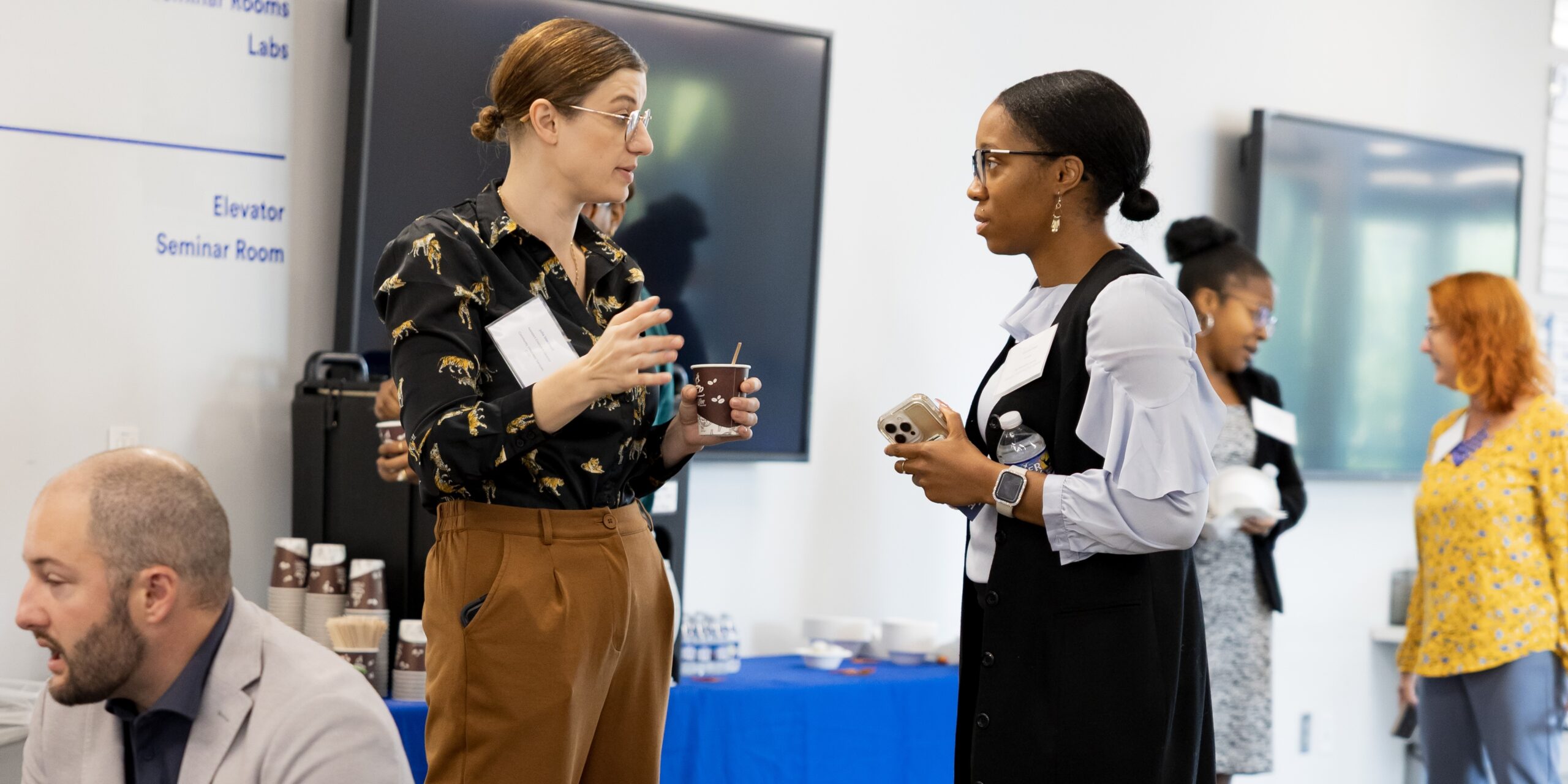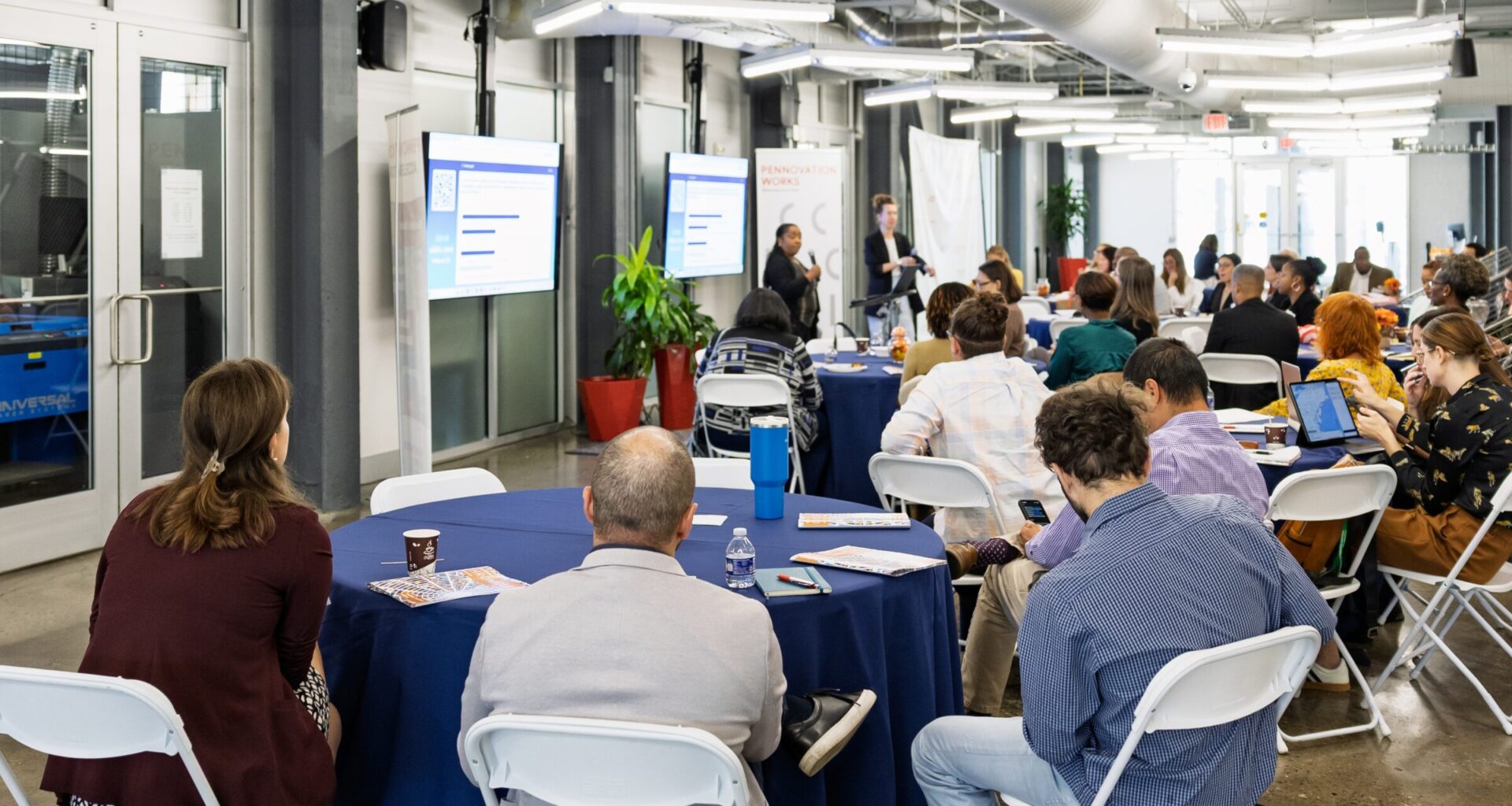At the beginning of October, more than 40 leaders from across three states gathered at the Pennovation Center in Philadelphia for a convening that felt more like a pivotal moment than a partnership meeting.
Nikki Pumphrey, vice president, talent and workforce at the Chamber of Commerce for Greater Philadelphia, set the tone early:
“Raise your hand if you’ve met someone new today,” Pumphrey said. Every hand went up. “We’ve already accomplished what we wanted to do.”
The comment captured the deeper purpose of the gathering, which was the second convening the Tech Council of Delaware has co-led under the America Achieves’ Good Jobs Economy Initiative, a national initiative helping regions strengthen economic mobility through cross-sector collaboration. In the Tri-State Area, the Tech Council of Delaware helped launch and continues to co-lead this work, building on the foundation laid under the leadership of former CEO Zakiyyah Ali. The effort unites leaders from Pennsylvania, New Jersey and Delaware to strengthen workforce systems and attract large-scale investments that expand access to good, livable wage jobs in high growth sectors.
The initial convening in June introduced the partnership — formally called the Tri-State Workforce Consortium — and shared a consultant’s SWOT analysis of the region. The October convening built momentum, turning the mic to regional leaders to discuss how to formalize a governance structure that can sustain long-term collaboration and prepare the region for large-scale funding opportunities.
Attendees came to the table from state and local workforce boards, chambers of commerce, higher education institutions, startups and nonprofit partners, all united by one goal: mutually beneficial collaboration. Today, organizations volunteer their time and are using finite funding, so it’s imperative to build an ongoing structure for workforce governance that stands alone.
Why now is a critical moment to organize — and avoid silos
Partnerships have historically been difficult to sustain when there is no shared funding opportunity to rally around. That is changing.
“Organizing as a region positions us to compete for major investments and turn collaboration into tangible results for employers and workers,” said Joshua Berkow, interim CEO of the Tech Council of Delaware. “Through this partnership, we’re building the infrastructure needed to attract funding, align employers, and strengthen the regional workforce.”
As new federal grants, philanthropic funds and industry partnerships materialize, it’s imperative that all three states coordinate as one region, not just a collection of local initiatives. Many convening attendees spoke about the missed connections that weaken the region’s potential on the national stage. For example, the Southern New Jersey Chamber of Commerce representative may not know what Philadelphia Works offers, or a university workforce center in Pennsylvania may not be aware of apprenticeship pathways emerging in Delaware.
Pumphrey, of the Greater Philadelphia Chamber, spoke on the foundation needed for a firm infrastructure.
“At the very fundamental level, we need to build awareness and trust,” she said. “Where is South Jersey thriving? What does Delaware have as an asset that doesn’t exist in southern New Jersey or Southeastern Pennsylvania?”
The Tri-State Workforce Consortium seeks to close those awareness gaps and align leaders on what’s needed to build collaboration across state lines.
Finding common ground and strategizing to engage employers
The group agreed on several challenges that need to be addressed to strengthen region-wide workforce development:
- Limited corporate/employer participation and direction
- Lack of a governance structure to guide collective decision-making and action
- Lack of a collective focus and shared strategic priorities
However, there was a notable absence of corporate representation in the room. Engaging employers meaningfully in regional partnerships isn’t as simple as generating awareness, said James (Jim) Harris, sector workforce strategist at the New Jersey Department of Labor & Workforce Development. To an employer, he said, “vast amounts of employer partners can be overwhelming.” To ensure meaningful engagement in the future, Harris recommended aligning with a handful of corporate partners who would assign specific company representatives to attend these convenings.
Stephanie Eldridge, CEO of Code Differently, pointed out many companies view workforce development as community engagement rather than a business investment.
“There’s an opportunity,” Eldridge said, “to work through organizations that directly draw in corporate organizations and employers, like Delaware Prosperity Partnership.” That way the consortium can position workforce engagement as part of business strategy, not volunteerism.
 Making connections to strengthen the region. (ILLUSTRATIVE LENS PHOTOGRAPHY/Tech Council of Delaware)
Making connections to strengthen the region. (ILLUSTRATIVE LENS PHOTOGRAPHY/Tech Council of Delaware)
Learning from setbacks: lessons from the Tech Hub competition
No conversation about regional collaboration could skip the lessons from the Tech Hub funding competition, where the tri-state region fell short of an award.
“It was a huge gut punch to our region,” admitted Tyrone Hampton, Jr., director, workforce partnerships at Philadelphia Works. “Around the country they had all the sexy numbers,” along with strong employer letters, a clear vision and deep engagement. Our region had letters of interest, not commitment.
“We didn’t get the funding because we didn’t have the infrastructure in place. We didn’t get the funding because we didn’t have the employer partnerships in place like the big anchor institutions. Once we saw who was awarded across the country, we saw that they had some of the things that we did not,” Hampton said.
The takeaway wasn’t just about losing funding, leaders agreed. It was about realizing the region didn’t yet have the connections, commitment and infrastructure to show we could manage it. That’s what the Tri-State Consortium is working to fix.
“The ideal workforce governance model is a model that is in place that brings people together,” Hampton said. “It fosters collaboration. It supports regional engagement, community engagement, inclusive decision making — all the things that help support a region having a oneness in terms of workforce efforts, and that engagement needed to impact communities.”
He added: “When you talk to most people, they have no idea about what a workforce governance model is. We emailed folks and they said, ‘I don’t know if I fit into the framework.’ And we said, yes, you do.”
What comes next? From intention to consistency
The Tri-State Consortium invited leaders to the table, and now it’s growing. Each convening strengthens the relationships, trust and shared direction needed to transform workforce efforts into a unified economic engine.
“This is really an effort to bring together a multi-state collaborative,” said Hampton, of Philadelphia Works.
That effort may very well draw inspiration from Delaware itself. “Delaware may be small, but we’ve proven we can punch above our weight when it comes to collaboration,” said Berkow. “By aligning our strengths across states and sectors, we’re showing what’s possible when a region comes together with a shared purpose — creating a blueprint for how collaboration can power economic mobility and opportunity.”
As federal agencies prepare to release new rounds of competitive funding, the groundwork being laid in 2025 could position the region as a national model for how collaboration drives readiness and resilience.
The Tech Council of Delaware and its partners intend to continue convening quarterly to formalize the governance model, solidify employer partnerships and ensure that when opportunity meets readiness, this region doesn’t just participate — it leads.
